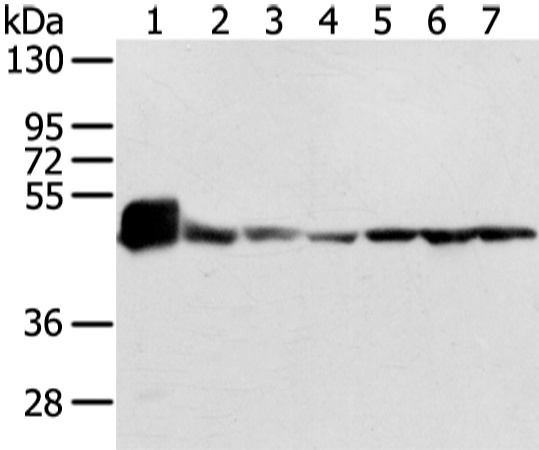


| WB | 1/500-1/2000 | Human,Mouse,Rat |
| IF | 咨询技术 | Human,Mouse,Rat |
| IHC | 1/20-1/100 | Human,Mouse,Rat |
| ICC | 技术咨询 | Human,Mouse,Rat |
| FCM | 咨询技术 | Human,Mouse,Rat |
| Elisa | 1/2000-1/5000 | Human,Mouse,Rat |
| Aliases | QCR1; UQCR1; D3S3191 |
| WB Predicted band size | 53 kDa |
| Host/Isotype | Rabbit IgG |
| Antibody Type | Primary antibody |
| Storage | Store at 4°C short term. Aliquot and store at -20°C long term. Avoid freeze/thaw cycles. |
| Species Reactivity | Human, Mouse, Rat |
| Immunogen | Fusion protein of human UQCRC1 |
| Formulation | Purified antibody in PBS with 0.05% sodium azide and 50% glycerol. |
+ +
以下是关于 **UQCRC1抗体** 的3篇参考文献,内容涵盖其功能研究及疾病相关性:
---
1. **文献名称**:*UQCRC1 mutations cause mitochondrial complex III deficiency with neurological dysfunction*
**作者**:Ghezzi D, et al.
**摘要**:该研究通过全外显子测序发现 **UQCRC1** 基因突变与线粒体复合体III功能缺陷相关,导致患者出现严重神经退行性症状。研究者利用特异性抗体进行Western blot和免疫组化分析,证实突变导致UQCRC1蛋白表达显著降低,并破坏线粒体呼吸链功能。
---
2. **文献名称**:*Proteomic analysis identifies UQCRC1 as a critical regulator of mitochondrial metabolism in colorectal cancer*
**作者**:Lee SY, et al.
**摘要**:通过蛋白质组学筛选,发现结直肠癌组织中 **UQCRC1** 表达异常升高,并与患者预后不良相关。研究使用UQCRC1抗体进行免疫沉淀和质谱分析,揭示其通过调控线粒体复合体III活性促进癌细胞增殖,靶向UQCRC1可抑制肿瘤生长。
---
3. **文献名称**:*Antibody-based profiling of mitochondrial respiratory chain complexes in Parkinson’s disease*
**作者**:Burbulla LF, et al.
**摘要**:该研究开发了针对线粒体呼吸链复合体(包括UQCRC1)的特异性抗体,用于分析帕金森病患者脑组织样本。结果显示,UQCRC1蛋白水平显著下降,提示复合体III功能障碍可能在帕金森病发病机制中起关键作用。
---
以上文献展示了 **UQCRC1抗体** 在疾病机制研究、代谢调控及诊断工具开发中的应用。如需具体文献链接或发表年份,可进一步补充信息。
The UQCRC1 antibody targets the Ubiquinol-Cytochrome c Reductase Core Protein 1 (UQCRC1), a key subunit of mitochondrial Complex III (cytochrome bc1 complex) in the electron transport chain. UQCRC1 is essential for oxidative phosphorylation, facilitating electron transfer from ubiquinol to cytochrome c and contributing to ATP synthesis. As a core structural component, it stabilizes Complex III and interacts with other subunits like UQCRC2 and cytochrome c1.
UQCRC1 antibodies are widely used in research to study mitochondrial function, respiratory chain disorders, and diseases linked to mitochondrial dysfunction, such as Parkinson’s, cancer, and Leigh syndrome. They enable detection of UQCRC1 expression via techniques like Western blotting, immunohistochemistry, and immunofluorescence, aiding in assessing mitochondrial protein levels in tissues or cultured cells.
Mutations in UQCRC1 are associated with mitochondrial encephalopathies and metabolic abnormalities, highlighting its clinical relevance. Studies also explore its role in apoptosis and reactive oxygen species regulation. Commercially available UQCRC1 antibodies vary in host species (e.g., rabbit, mouse) and clonality, requiring validation for specificity, as cross-reactivity with homologous proteins may occur. Research using these antibodies enhances understanding of mitochondrial biology and disease mechanisms.
×